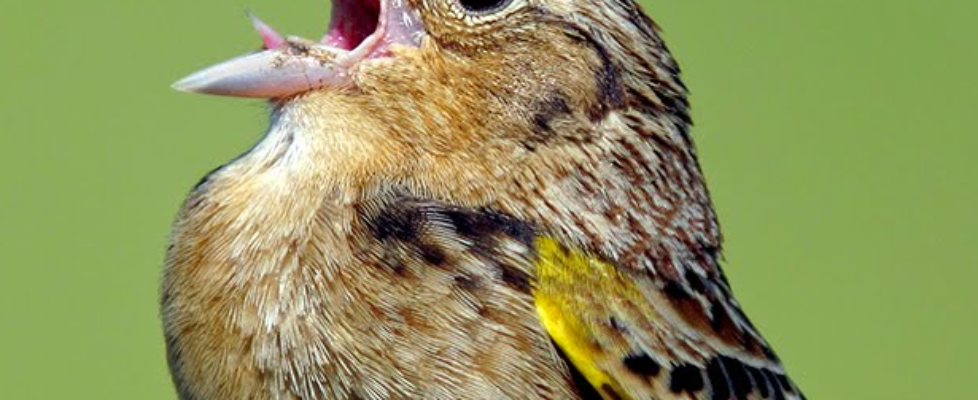How eBirding is helping Grasshopper Sparrows at Croton Point
An April 2016 article in the journal Biological Conservation considered how birding data collected in eBird can be a valuable tool in the conservation of birds and their habitats. One example cited is the effort by Saw Mill River Audubon at Croton Point Park to encourage the nesting of grassland species, including Grasshopper Sparrows.
(To learn more about eBird, come to the Thursday, January 19, 2017, 7:00 pm public program, “Get into eBirding,” at Teatown Lake Reservation.)
Excerpt from above journal article:
Croton Point County Park is a 504-acre peninsula on the Westchester County Hudson River shoreline in New York, USA. Starting in the 1920s, over 100 acres of this peninsula was converted from tidal marsh to municipal landfill. In the early 1990s this landfill was capped and Saw Mill River Audubon helped convince Westchester County to establish native grassland habitat on the landfill cap. However, over the last two decades proper maintenance of the grasslands has proven to be an ongoing challenge. Croton Point County Park is within the Lower Hudson River Important Bird Area, and as a popular birding spot, the site has good birder coverage and the second highest number of eBird records of any location in the county. eBird data documented that grassland birds otherwise uncommon in the region (e.g., Grasshopper Sparrow (Ammodramus savannarum), Savannah Sparrow (Passerculus sandwichensis), Bobolink (Dolichonyx oryzivorus), and Eastern Meadowlark (Sturnella magna) were attempting to nest in the landfill grassland habitat, but were being prevented in doing so by poor mowing practices. Over the last three years, better mowing practices have resulted in eBird-documented nesting success in all four grassland species. In 2014, three nesting pairs of Grasshopper Sparrows were the only nesting records in the Lower Hudson Valley. In 2015, new nest boxes for American Kestrel and new nesting platforms for Osprey were added based on eBird records of high spring numbers of both species visiting this site. Records from eBird have also documented year-to-year migrant use of the landfill grasslands by several other grassland species that are scarce in the region.
Complete text of “Using open access observational data for conservation action: A case study for birds” is at http://andreawiggins.com/wp-content/uploads/2013/10/Sullivan-et-al.-2016_Biological-Conservation.pdf
Overall summary of journal article
Ensuring that conservation decisions are informed by the best available data is a fundamental challenge in the face of rapid global environmental change. Too often, new science is not easily or quickly translated into conservation action. Traditional approaches to data collection and science delivery may be both inefficient and insufficient, as conservation practitioners need access to salient, credible, and legitimate data to take action. Open access data could serve as a tool to help bridge the gap between science and action, by providing conservation practitioners with access to relevant data in near real time. Broad-scale citizen-science data represent a fast-growing resource for open access databases, providing relevant and appropriately scaled data on organisms, much in the way autonomous sensors do so on the environment. Several such datasets are now broadly available, yet documentation of their application to conservation is rare. Here we use eBird, a project where individuals around the world submit data on bird distribution and abundance, as an example of how citizen-science data can be used to achieve tangible conservation science and action at local, regional, and global scales. Our examination illustrates how these data can be strategically applied to improve our understanding of spatial and temporal distributions of birds, the impacts of anthropogenic change on ecological systems, and creative conservation solutions to complex problems. We raise awareness of the types of conservation action now happening with citizen-science data, and discuss the benefits, limitations, and caveats of this approach
Citation
Sullivan, B.L., et al., Using open access observational data for conservation action: A case study for birds, Biological Conservation (2016), http://dx.doi.org/10.1016/j.biocon.2016.04.031
Photo credit
Grasshopper Sparrow, Kevin Bolton.



